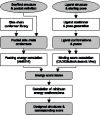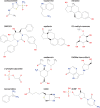Binding pocket optimization by computational protein design
- PMID: 23300688
- PMCID: PMC3531388
- DOI: 10.1371/journal.pone.0052505
Binding pocket optimization by computational protein design
Abstract
Engineering specific interactions between proteins and small molecules is extremely useful for biological studies, as these interactions are essential for molecular recognition. Furthermore, many biotechnological applications are made possible by such an engineering approach, ranging from biosensors to the design of custom enzyme catalysts. Here, we present a novel method for the computational design of protein-small ligand binding named PocketOptimizer. The program can be used to modify protein binding pocket residues to improve or establish binding of a small molecule. It is a modular pipeline based on a number of customizable molecular modeling tools to predict mutations that alter the affinity of a target protein to its ligand. At its heart it uses a receptor-ligand scoring function to estimate the binding free energy between protein and ligand. We compiled a benchmark set that we used to systematically assess the performance of our method. It consists of proteins for which mutational variants with different binding affinities for their ligands and experimentally determined structures exist. Within this test set PocketOptimizer correctly predicts the mutant with the higher affinity in about 69% of the cases. A detailed analysis of the results reveals that the strengths of PocketOptimizer lie in the correct introduction of stabilizing hydrogen bonds to the ligand, as well as in the improved geometric complemetarity between ligand and binding pocket. Apart from the novel method for binding pocket design we also introduce a much needed benchmark data set for the comparison of affinities of mutant binding pockets, and that we use to asses programs for in silico design of ligand binding.
Conflict of interest statement
Figures



 , HP: HIV-1 protease, KI: Ketosteroid isomerase, L: Lectin, MS: Methylglyoxal synthase, N1: Neuroaminidase test 1, N2: Neuroaminidase test 2, PNP: Purine nucleoside phosphorylase, S1: Streptavidin test 1, S2: Streptavidin test 2, TS: Thymidylate synthase, T: Trypsin.
, HP: HIV-1 protease, KI: Ketosteroid isomerase, L: Lectin, MS: Methylglyoxal synthase, N1: Neuroaminidase test 1, N2: Neuroaminidase test 2, PNP: Purine nucleoside phosphorylase, S1: Streptavidin test 1, S2: Streptavidin test 2, TS: Thymidylate synthase, T: Trypsin.
References
-
- Röthlisberger D, Khersonsky O, Wollacott AM, Jiang L, DeChancie J, et al. (2008) Kemp elimination catalysts by computational enzyme design. Nature 453: 190–195. - PubMed
Publication types
MeSH terms
Substances
LinkOut - more resources
Full Text Sources

